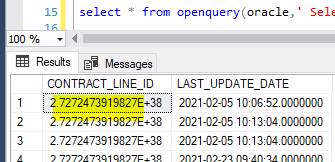Hi Team :
I am running this below query in SQL SSMS 2008 vs SSMS 2018
The Oracle linked server is same in both the versions
select * from openquery(oracle,' Select contract_line_id , LAST_UPDATE_DATE from cs_estimate_details where contract_line_id = 272724739198270094939365006910151744014')
So, in the 2008 version, it's giving me the correct number as we have in oracle through a linked server.

But if i run the same query in new version SQL SSMS 2018. Its giving me E+ value.

I know if we convert this to varchar in SQL 2018, it gives us the correct value ( the full value). But just want to know what's causing this to happen?
select * from openquery(oracle,' Select cast (contract_line_id as varchar(768)) as New_contract , LAST_UPDATE_DATE from cs_estimate_details where contract_line_id = 272724739198270094939365006910151744014')
is this something with the SQL version compatibility ( SQL 2008 is 100 and SQL 2018 is 140 compatibility level)? The column contract_line_id is nvarchar in the SQL table.
Thanks




